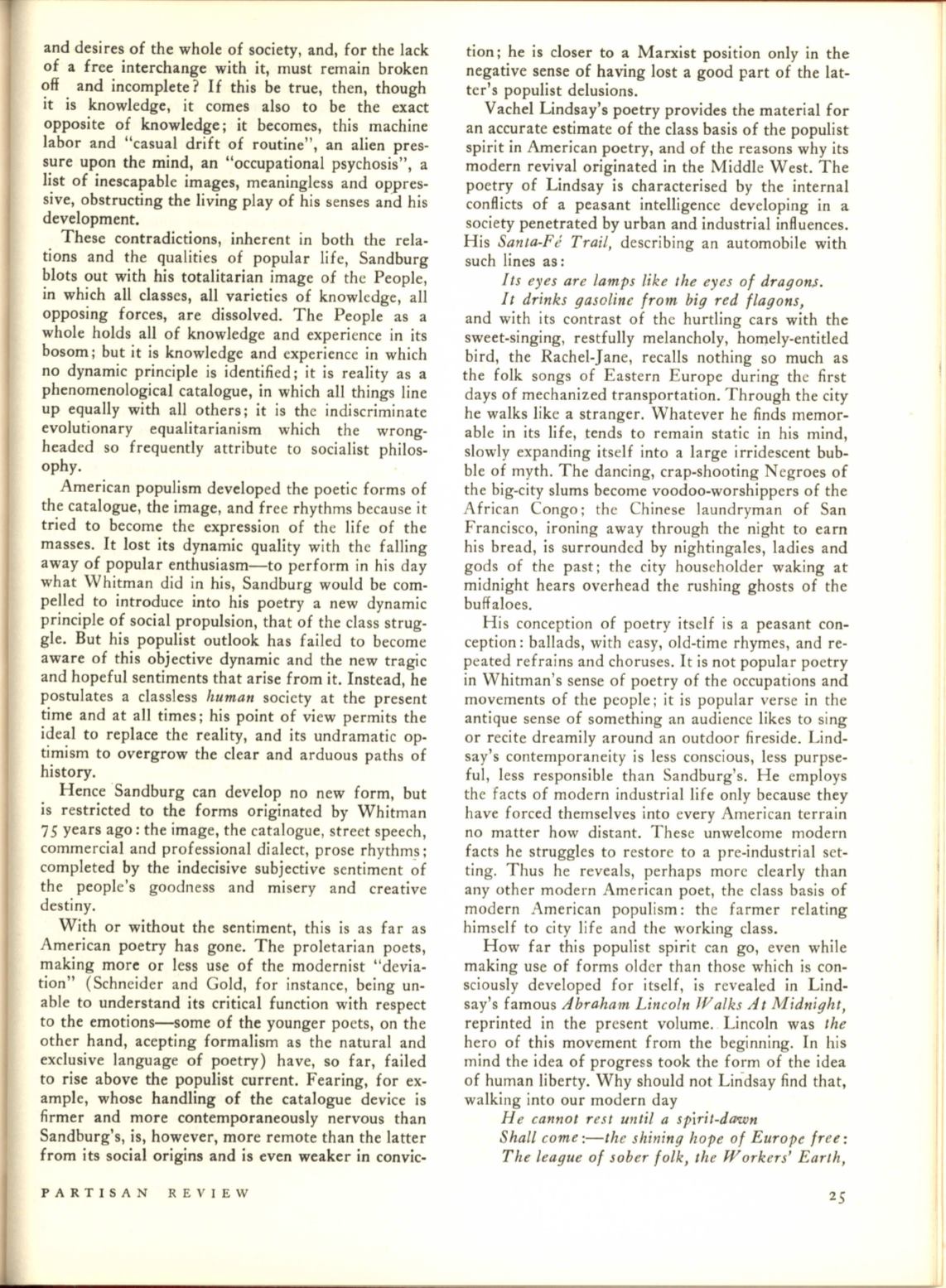
and desires of the whole of society, and, for the lack
of a free interchange with it, must remain broken
off and incomplete? If this be true, then, though
it is knowledge, it comes also to be the exact
opposite of knowledge; it becomes, this machine
labor and "casual drift of routine", an alien pres-
sure upon the mind, an "occupational psychosis", a
list of inescapable images, meaningless and oppres-
sive, obstructing the living play of his senses and his
development.
These contradictions, inherent in both the rela-
tions and the qualities of popular life, Sandburg
blots out with his totalitarian image of the People,
in which all classes, all varieties of knowledge, all
opposing forces, are dissolved. The People as a
whole holds all of knowledge and experience in its
bosom; but it is knowledge and experience in which
no dynamic principle is identified; it is reality as a
phenomenological catalogue, in which all things line
up equally with all others; it is the indiscriminate
evolutionary equalitarianism which the wrong-
headed so frequently attribute to socialist philos-
ophy.
American populism developed the poetic forms of
the catalogue, the image, and free rhythms because it
tried to become the expression of the life of the
masses. It lost its dynamic quality with the falling
away of popular enthusiasm-to perform in his day
what Whitman did in his, Sandburg would be com-
pelled to introduce into his poetry a new dynamic
principle of social propulsion, that of the class strug-
gle. But his populist outlook has failed to become
aware of this objective dynamic and the new tragic
and hopeful sentiments that arise from it. Instead, he
postulates a classless
human
society at the present
time and at all times; his point of view permits the
ideal to replace the reality, and its undramatic op-
timism to overgrow the clear and arduous paths of
history.
Hence Sandburg can develop no new form, but
is restricted to the forms originated by Whitman
7 S
years ago: the image, the catalogue, street speech,
commercial and professional dialect, prose rhythm~;
completed by the indecisive subjective sentiment of
the people's goodness and misery and creative
destiny.
With or without the sentiment, this is as far as
American poetry has gone. The proletarian poets,
making more or less use of the modernist "devia-
tion" (Schneider and Gold, for instance, being un-
able to understand its critical function with respect
to the emotions-some of the younger poets, on the
other hand, acepting formalism as the natural and
exclusive language of poetry) have, so far, failed
to rise above the populist current. Fearing, for ex-
ample, whose handling of the catalogue device is
firmer and more contemporaneously nervous than
Sandburg's, is, however, more remote than the latter
from its social origins and is even weaker in convic-
PARTISAN
REVIEW
tion; he is closer to a Marxist position only in the
negative sense of having lost a good part of the lat-
ter's populist delusions.
Vachel Lindsay's poetry provides the material for
an accurate estimate of the class basis of the populist
spirit in American poetry, and of the reasons why its
modern revival originated in the Middle West. The
poetry of Lindsay is characterised by the internal
conflicts of a peasant intelligence developing in a
society penetrated by urban and industrial influences.
His
Santa-Fe Trail,
describing an automobile with
such lines as:
Its eyes are lamps like the eyes of dragons.
It drinks gasoline from big red flagons,
and with its contrast of the hurtling cars with the
sweet-singing, restfully melancholy, homely-entitled
bird, the Rachel-Jane, recalls nothing so much as
the folk songs of Eastern Europe during the first
days of mechanized transportation. Through the city
he walks like a stranger. Whatever he finds memor-
able in its life, tends to remain static in his mind,
slowly expanding itself into a large irridescent bub-
ble of myth. The dancing, crap-shooting Negroes of
the big-city slums become voodoo-worshippers of the
African Congo; the Chinese laundryman of San
Francisco, ironing away through the night to earn
his bread, is surrounded by nightingales, ladies and
gods of the past; the city householder waking at
midnight hears overhead the rushing ghosts of the
buffaloes.
His conception of poetry itself is a peasant con-
ception: ballads, with easy, old-time rhymes, and re-
peated refrains and choruses. It is not popular poetry
in Whitman's sense of poetry of the occupations and
movements of the people; it is popular verse in the
antique sense of something an audience likes to sing
or recite dreamily around an outdoor fireside. Lind-
say's contemporaneity is less conscious, less purpse-
ful, less responsible than Sandburg's. He employs
the facts of modern industrial life only because they
have forced themselves into every American terrain
no matter how distant. These unwelcome modern
facts he struggles to restore to a pre-industrial set-
ting. Thus he reveals, perhaps more clearly than
any other modern American poet, the class basis of
modern American populism: the farmer relating
himself to city life and the working class.
How far this populist spirit can go, even while
making use of forms older than those which is con-
sciously developed for itself, is revealed in Lind-
say's famous
Abraham Lincoln lValks At Midnight,
reprinted in the present volume. Lincoln was
the
hero of this movement from the beginning. In his
mind the idea of progress took the form of the idea
of human liberty. Why should not Lindsay find that,
walking into our modern day
He cannot rest until a spirit-dtllWn
Shall come :-the shining hope of Europe free:
The league of sober folk, the Workers'
Earth,
2S


